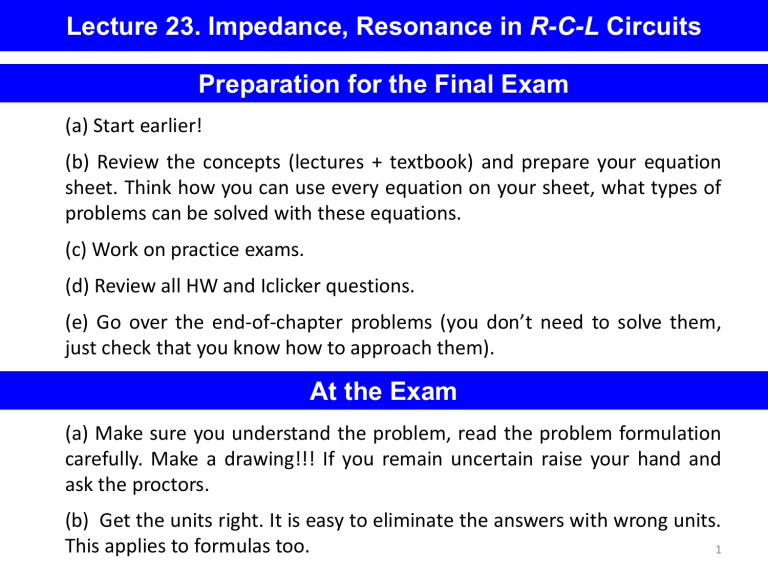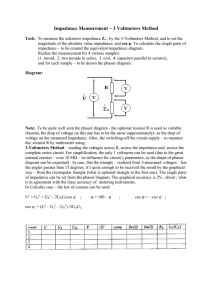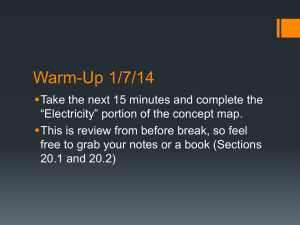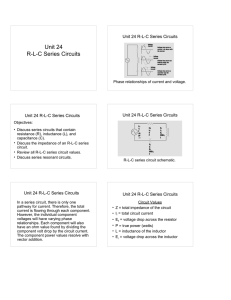R-C-L Preparation for the Final Exam
advertisement

Lecture 23. Impedance, Resonance in R-C-L Circuits Preparation for the Final Exam (a) Start earlier! (b) Review the concepts (lectures + textbook) and prepare your equation sheet. Think how you can use every equation on your sheet, what types of problems can be solved with these equations. (c) Work on practice exams. (d) Review all HW and Iclicker questions. (e) Go over the end-of-chapter problems (you don’t need to solve them, just check that you know how to approach them). At the Exam (a) Make sure you understand the problem, read the problem formulation carefully. Make a drawing!!! If you remain uncertain raise your hand and ask the proctors. (b) Get the units right. It is easy to eliminate the answers with wrong units. This applies to formulas too. 1 Reactance (recap) Resistor 𝑋𝑅 = 𝑅 𝑉 = 𝐼𝑅 = 𝐼𝑋𝑅 Capacitor 1 𝑋𝐶 = 𝜔𝜔 𝑉 𝑡 =𝐼 𝑡 Inductor −𝑖 𝑋𝐶 𝑋𝐿 = 𝜔𝐿 𝑉 𝑡 = 𝐼 𝑡 𝑖𝑋𝐿 AC (cos 𝜔𝜔 + 𝜑 ) driven circuits! 2 Impedance 𝑉 𝑡 𝐼 𝑡 Impedance 𝑍 is a measure of how much the circuit impedes the flow of current. The impedance is a complex number (time-independent phasor), it relates timedependent phasors V(t) and I(t). RLC 𝑍= 𝑍 𝑒 𝑖𝑖 𝑍0 ≡ 𝑍 𝑉 𝑡 = 𝐼 𝑡 𝑉 𝑡 =𝐼 𝑡 𝑍 𝑉𝑟𝑟𝑟 𝑒 𝑖𝜔𝑡 = 𝐼𝑟𝑟𝑟 𝑒 𝑖𝑖𝑖−𝑖𝑖 𝑍 𝑒 𝑖𝑖 𝑉𝑟𝑟𝑟 = 𝐼𝑟𝑟𝑟 𝑒 −𝑖𝑖 𝑍 𝑒 𝑖𝑖 Reactances: Impedances: 𝑉𝑟𝑟𝑟 = 𝐼𝑟𝑟𝑟 𝑍 𝐼𝐼 𝐼 −𝜙 𝜙 𝑉 𝑅𝑅 𝑍 𝑉 is the reference phasor all terms are real 𝑋𝑅 = 𝑅 𝑍𝑅 = 𝑅 1 𝑋𝐿 = 𝜔𝐿 𝜔𝜔 1 𝑍𝐿 = 𝑖𝜔𝐿 𝑍𝐶 = 𝑖𝜔𝜔 𝑋𝐶 = 3 C circuit 𝑉 𝑡 𝐼 𝑡 𝑉𝑟𝑟𝑟 = 𝐼𝑟𝑟𝑟 𝑍𝐶 𝐼𝑟𝑟𝑟 Can we plug a 1-µF capacitor into a wall outlet 𝑟𝑟𝑟 (𝜔 = 2𝜋 ∙ 60 , 𝑉𝑟𝑟𝑟 = 120𝑉) if the circuit breakers 𝑠 can take 15A ? 𝐼𝑟𝑟𝑟 = 𝜔𝜔 𝑍𝐶 𝑉𝑟𝑟𝑟 120𝑉 = = = 45𝑚𝑚 𝑋𝑐 2650Ω 1 1 = 𝑋𝐶 = = Ω = 2650Ω 𝜔𝜔 2𝜋 ∙ 60 ∙ 1 ∙ 10−6 This current is sufficiently small. The primary concern is the voltage rating of the capacitor, which should be around 200V. Current (reference phasor) Voltage −𝑖 𝑉 𝑡 = 𝐼 𝑡 𝑍𝐶 = 𝐼 𝑡 𝜔𝐶 4 L circuit 𝑉 𝑡 𝐼 𝑡 What happens when we plug a 1-H inductor into a wall outlet? 𝑉𝑟𝑟𝑟 = 𝐼𝑟𝑟𝑟 𝑍𝐿 = 𝜔𝜔 𝐼𝑟𝑟𝑟 𝐼𝑟𝑟𝑟 𝑉𝑟𝑟𝑟 120𝑉 = = = 0.32𝐴 𝑋𝐿 377Ω 𝑍𝐿 = 𝑋𝐿 = 𝜔𝜔 = 2𝜋 ∙ 60 ∙ 1Ω = 377Ω Again, the current won’t blow a circuit breakers. The inductor must be designed to carry 0.32A without overheating or saturating the iron core. Current (reference phasor) Voltage 𝑉 𝑡 = 𝐼 𝑡 𝑍𝐿 = 𝐼 𝑡 𝑖𝑖𝐿 5 Series R-C circuit 𝑍 = 𝑍𝑅 + 𝑍𝐶 = 𝑅 − 𝑖𝑋𝑐 𝐼𝐼 − 1 𝜔𝜔 𝑍 = 𝜙 𝑅 𝑍 𝑅𝑅 𝑅2 + 𝑋𝑐 2 𝑍 = 𝑍 𝑒 𝑖𝑖 𝐼𝐼𝐼 −𝑋𝐶 𝜑 = 𝑎𝑎𝑎𝑎𝑎𝑎 = 𝑎𝑎𝑎𝑎𝑎𝑎 𝑅 𝑅𝑅𝑅 𝑉𝑟𝑟𝑟 = 𝐼𝑟𝑟𝑟 𝑅2 + 𝑋𝑐 2 = 𝐼𝑟𝑟𝑟 −𝜑 𝜑 1 2 𝑅 + 𝜔𝐶 2 𝑉 𝑡 = 𝐼 𝑡 𝑍 = 𝐼(𝑡) 𝑅 − 𝑖𝑋𝑐 𝑉0 𝑒 𝑖𝑖𝑖 = 𝐼0 𝑒 𝑖 𝜔𝜔−𝜙 𝑍 𝑒 𝑖𝑖 6 R-C circuits: Example 𝐼𝐼 − 𝜙 1 𝜔𝜔 𝐼𝐼 −𝜙 𝜙 𝑅 𝑍 𝐼 𝑍 𝑅𝑅 𝐼𝐼𝐼 −𝑋𝐶 1 𝜑 = 𝑎𝑎𝑎𝑎𝑎𝑎 = 𝑎𝑎𝑎𝑎𝑎𝑎 𝑍 =𝑅−𝑖 𝑅 𝑅𝑅𝑅 𝜔𝜔 1 1 𝜔𝜔 tan 𝜙 = − =− = −50 3 −6 𝑅 1 ∙ 10 ∙ 100 ∙ 0.2 ∙ 10 𝑒 𝑖𝑖 Note that 𝜙 is negative (as it should be for the RC circuits). 𝑉𝑖𝑖 𝑅𝑅 𝑉(𝑡) = 𝐼(𝑡)𝑍 𝑉0 𝑒 𝑖𝑖𝑖 = 𝐼0 𝑒 𝑖 𝜔𝜔−𝜙 𝑍 𝑒 𝑖𝑖 7 Low-Pass Filter Goal: to suppress high-frequency (𝑓 > 𝑓0 ) components in the spectrum of a signal. 𝑉𝑖𝑖 = 𝐼 𝑅 − 𝑖𝑋𝑐 𝑍 = 𝑅 − 𝑖𝑋𝑐 𝑍 = 𝑉𝑖𝑖 = 𝐼 𝑅2 + 𝑋𝑐 2 𝑅2 + 𝑋𝑐 2 𝑉𝑜𝑜𝑜 = 𝑉𝑖𝑖 Output power: 𝑉𝑜𝑜𝑜 𝑉𝑖𝑖 2 = 1 𝜔𝜏𝑅𝑅 2 +1 𝑋𝑐 𝑅 2 + 𝑋𝑐 2 1 1 𝜔𝜏𝑅𝑅 Cutoff frequency: 𝜔0 = 2𝜋𝑓0 = = 𝑅2 𝜔≪ 2 1 𝑅𝑅 𝜔≫ We want to suppress the high-frequency (𝑓 > 10𝑘𝑘𝑘) components in the output of an audio amplifier with the output resistance 100 Ω. What capacitance do you need? 𝑰 𝑉𝑜𝑜𝑜 = 𝐼 −𝑖𝑋𝑐 1 𝜔𝐶 1 + 𝜔𝜔 1 𝜏𝑅𝑅 1 𝜏𝑅𝑅 𝐶= 2 1 𝜔𝑅𝐶 𝑉𝑖𝑖 𝑽𝑪 = 𝑽𝒐𝒐𝒐 𝑉𝑜𝑜𝑜 = 𝐼𝑋𝑐 = 𝑽𝑹 2 +1 = 1 𝜔𝜏𝑅𝑅 2 𝑍 +1 = two times 1 1 = 𝐹 = 160𝑛𝑛 2𝜋𝑓0 𝑅 2𝜋104 ∙ 100 8 Series R-L-C Circuits For R, C, and L in series: 𝑍 = 𝑅 + 𝑖𝑋𝐿 − 𝑖𝑋𝑐 = 𝑅 + 𝑖 𝜔𝜔 − 𝑍 = 𝑍 ∙ 𝑍∗ = 𝐼 1 𝑅2 + 𝜔𝜔 − 𝜔𝜔 𝑉𝑟𝑟𝑟 = 𝐼𝑟𝑟𝑟 𝑍 = 𝐼𝑟𝑟𝑟 𝑖𝐼𝐼𝐿 −𝑖𝐼𝐼𝐶 2 1 2 𝑅 + 𝜔𝜔 − 𝜔𝜔 𝑉(𝑡) = 𝐼(𝑡) 𝑅 + 𝑖 𝜔𝜔 − 1 𝜔𝜔 ? 𝜔𝜔 1 𝜔𝜔 2 1 𝜔𝜔 9 Series R-L-C circuits: Example 1 𝑉𝐿 = 𝑖𝜔𝐿𝐿 𝑉𝑟𝑟𝑟 𝐿 = 2.2 ∙ 80 = 176𝑉 𝑉𝑅 𝑉𝑟𝑟𝑟 𝑅 = 2.2 ∙ 40 = 88𝑉 𝑉𝑠 𝑉𝑟𝑟𝑟 𝐶 = 2.2 ∙ 110 = 242𝑉 𝑉𝐶 = −𝑖 𝐼 𝜔𝜔 𝑉𝑟𝑟𝑟 = 𝐼𝑟𝑟𝑟 𝑍 = 𝐼𝑟𝑟𝑟 1 𝑅2 + 𝜔𝜔 − 𝜔𝜔 𝑉𝑟𝑟𝑟 = 2.2 402 + 80 − 110 2 = 110𝑉 2 10 Series R-L-C circuits: Example 2 An R-L-C series circuit with an inductance of 0.119H , a resistance of 244 Ω, and a capacitance of 7.27 µF carries an rms current of 0.446A with a frequency of 391Hz . 1. What is the impedance of the circuit? 1 𝑍 = 𝑅 + 𝑖𝑋𝐿 − 𝑖𝑋𝑐 = 𝑅 + 𝑖 𝜔𝜔 − 𝜔𝜔 2. What is the phase angle? tan 𝜙 = 𝑍0 = 𝜔 = 2455 𝑟𝑟𝑟/𝑠 1 𝑅2 + 𝜔𝜔 − 𝜔𝜔 1 −6 𝜔𝐶 = 2455 ∙ 0.119 − 2455 ∙ 7.27 ∙ 10 𝑅 244 𝜔𝐿 − 3. What is the rms voltage of the source? −1 ≈ 0.97 2 = 339Ω 𝐼𝐼 𝜙 −𝜙 arctan 0.97 ≈ 0.77 𝑟𝑟𝑟 𝑍 𝐼 𝑉 𝑅𝑅 𝑉𝑟𝑟𝑟 = 𝐼𝑟𝑟𝑟 ∙ 𝑍0 = 0.446𝐴 ∙ 339Ω = 151𝑉 4. What average power is delivered by the source? cos 0.77 = 0.72 - power factor for this circuit 𝑃𝑎𝑎 = 𝑉𝑟𝑟𝑟 ∙ 𝐼𝑟𝑟𝑟 cos 𝜙 = 151 ∙ 0.446 ∙ 0.72 = 48.6𝑊 - average rate at which electrical energy is converted to thermal energy in the resistor 11 Parallel R-L-C Circuit: Example 𝑃𝑎𝑎 = 𝑉𝑟𝑟𝑟 ∙ 𝐼𝑟𝑟𝑟 cos 𝜙 1 1 1 = + 𝑖 𝜔𝜔 − 𝑍 𝑅 𝜔𝜔 1 = 𝑍 𝐼𝐼 𝜙 −𝜙 𝑍 𝐼 𝑉 𝑅𝑅 tan 𝜙 = 𝐼𝑟𝑟𝑟 1 𝜔𝜔 = 3 1/𝑅 4 cos 𝜙 = 1 1 + 𝑡𝑡𝑡2 𝜙 1 𝑉𝑟𝑟𝑟 1 = = 𝑉𝑟𝑟𝑟 2 + 𝜔𝜔 − 𝑍 𝑅 𝜔𝜔 𝑃𝑎𝑎 = 𝑉𝑟𝑟𝑟 ∙ 𝐼𝑟𝑟𝑟 cos 𝜙 = 2 1 1 − 𝑖 𝜔𝜔 − 𝜔𝜔 𝑍= = 𝑅 2 1 1 1 1 + 𝑖 𝜔𝜔 − + 𝜔𝜔 − 𝜔𝜔 𝑅 𝜔𝜔 𝑅2 1 𝜔𝜔 − 1 1 + 𝜔𝜔 − 𝑅2 𝜔𝜔 2 = = 4 5 1 + 6−3 2 0.252 10 10 50 4 ∙ ∙ = 200𝑊 2 2 5 2 = 50 2 𝐴 12 Series Resonance in the R-L-C circuits 𝐼 For R, C, and L in series: 1 𝑅 2 + 𝜔𝜔 − 𝜔𝜔 𝑍 = 𝑍 ∙ 𝑍∗ = 𝐼 = Resonance condition: 𝜔𝜔 = 1 𝜔𝜔 𝑉 = 𝑍 𝜔0 = 1 1 𝑍 = 𝑅 + 𝑖𝑋𝐿 − 𝑖𝑋𝑐 = 𝑅 + 𝑖 𝜔𝜔 − 𝜔𝜔 𝑅2 𝑉 1 + 𝜔𝜔 − 𝜔𝜔 2 2 - resonance 𝐿𝐿 frequency At 𝜔 =𝜔0 minimum (real) impedance, max current. Note that at 𝜔 =𝜔0 , 𝑉𝐶 and 𝑉𝐿 can be greater than 𝑉. 𝜔 > 𝜔0 𝜔 < 𝜔0 𝜔 = 𝜔0 13 Parallel Resonance in the R-L-C circuits 𝐼 1 1 1 𝜔𝐶 1 1 1 1 1 = + + = −𝑖 +𝑖 = + 𝑖 𝜔𝜔 − 𝑍 𝑅 𝑖𝑖𝑖 −𝑖 𝑅 𝑋𝐿 𝑋𝐶 𝑅 𝜔𝜔 1 = 𝑍 At the resonance frequency 𝜔0 = 1 𝐿𝐿 1 𝑉 1 𝐼 = = 𝑉 2 + 𝜔𝜔 − 𝑍 𝜔𝜔 𝑅 min at 𝜔𝜔 = 2 1 1 + 𝜔𝐶 − 𝑅2 𝜔𝐿 1 𝑍 2 is at its minimum 𝜔 → 0 𝐿 is a “short” 𝜔 → ∞ 𝐶 is a “short” 1 𝜔𝜔 Note that at 𝜔 =𝜔0 , 𝐼𝐶 and 𝐼𝐿 can be greater than 𝐼. R = 1Ω, C = 1F, L = 1H, and V = 1V 16 Transformer Φ𝐵 - the flux per turn 𝑑Φ𝐵 𝑑𝑑 𝑑Φ𝐵 ℇ𝑠 = −𝑁𝑠 𝑑𝑑 ℇ𝑝 = −𝑁𝑝 For an ideal transformer (𝑅𝑠 = 𝑅𝑝 = 0): Energy conservation: 𝐼𝑠 𝑁𝑝 = 𝐼𝑝 𝑁𝑠 𝑉𝑝 𝑁𝑝 = 𝑁𝑠 𝑉𝑠 2 𝐼𝑝 2 1 𝑉𝑠 𝐼𝑠 𝑀≡ 𝑉𝑝 𝑁𝑝 = 𝐼𝑝 𝑁𝑠 2 𝑅 Φ𝑠 𝑁𝑠 Φ𝐵 = 𝐼𝑝 𝐼𝑝 𝑀 𝑑𝐼𝑝 𝑑Φ𝐵 = 𝑁𝑠 𝑑𝑑 𝑑𝑑 𝐿𝑝 𝐿𝑠 : ℇ𝑠 = 𝑀 𝑉𝑝 𝑁𝑝 = 𝑉𝑠 𝑁𝑠 𝑉𝑝 𝐼𝑝 = 𝑉𝑠 𝐼𝑠 2 𝑁𝑝 𝑅 𝑁𝑠 “impedance transformation” - as if the source had been connected directly to a resistance Using mutual inductance 𝑀 = ℇ𝑝 𝑁𝑝 = ℇ𝑠 𝑁𝑠 𝑑𝐼𝑝 𝑑𝑑 17 Example Sloppy formulation ℇ𝑠 𝑀= 𝑑𝐼𝑝 =𝑀 = 𝐼𝑠 𝑅𝑠 𝑑𝑑 𝐼𝑠 𝑅𝑠 0.4 ∙ cos 377𝑡 12 = = 2.55𝑚𝑚 𝑑𝐼𝑝 377 ∙ 5 ∙ cos 377𝑡 𝑑𝑑 ℇ𝑠 = 𝑀 𝑑𝐼𝑝 = 𝑀 6𝑡 = 10 ∙ 10−3 ∙ 6 ∙ 3 𝑑𝑑 = 0.18𝑉 18 Next time: Lecture 24. Electromagnetic Waves, §§ 32.1 - 4 19







